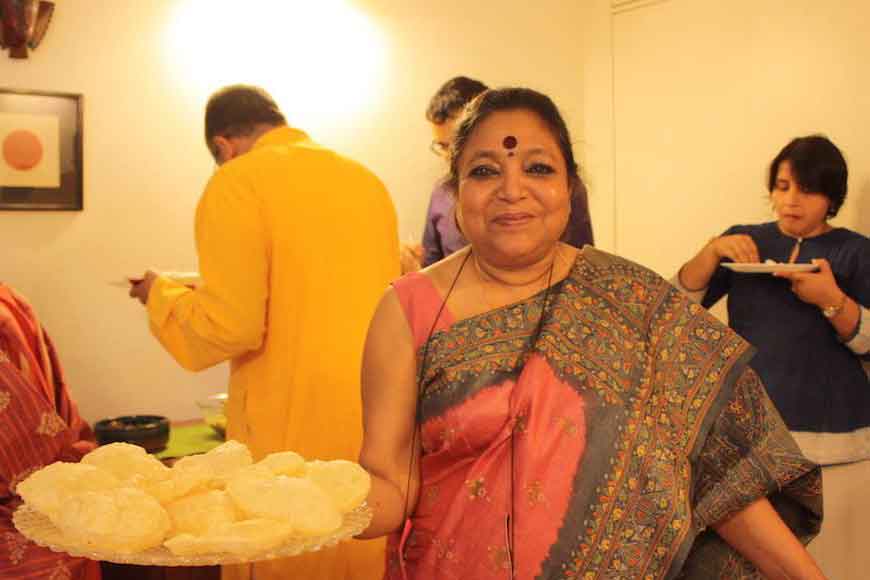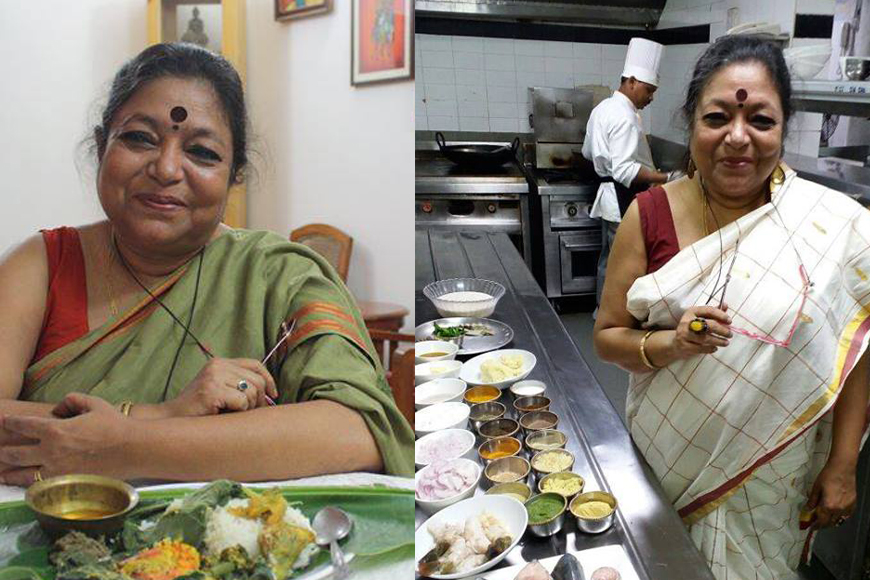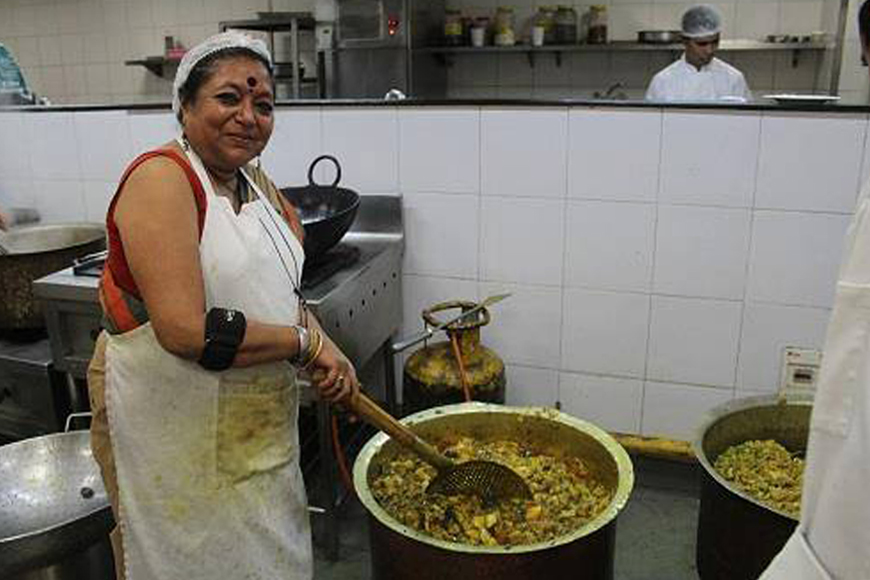Pritha Sen weaves stories through Bengali dishes

Pritha Sen is not just a celebrated food historian and journalist from Kolkata, she has been instrumental in bringing Bengali cuisine to the world. Be it the Goalondo Steamer Trail or whipping up Bengali cuisine in a celebrated restaurant of Goa, Pritha believes Bengali cuisine has the old age wisdom that can teach the world many hidden secrets of fine dining. She gives an exclusive interview to GetBengal
• Why and what did you document in ‘Indigenous Heritage Cuisine of Bengal?’
When I say Indigenous Heritage Cuisine, I mean everything that goes with it from the time that the region consolidated to form the Bengal region and beyond. From the ways of eating, cooking techniques and styles and indigenous produce that existed, many of which are fading from public memory. To make it interesting for the lay person, I weave themes or a story around it. Story telling is always the best way of communication and generating interest. I document influences, recipes and folklore and history that revolves round the cuisine that developed. Partition fragmented Bengal and was also responsible for changing a once-shared culture. Documentation helps to jog memory and revive culinary heritage and protect it.
• You write extensively on food history and nutrition for various publications. How do you think such columns help to revive forgotten cuisines?
It makes people look closer to their own food. It makes them ask questions and look into their own family recipes and legacies. It makes people want to share. I have had people couriering me compilations of their family recipes, which means they looked into their own kitchens and felt a sense of pride. That’s the pride I wish to bring back in one’s own food, born out of indigenous local wisdom, seasonality and maximum nutrition, instead of looking westward for everything, which is not ours at all. When I first started writing on our food and posting on social media groups as well, I would get hate mail in my inbox from Bengalis telling me to pull down posts because they were ashamed of being known to eat chhyanchra and kanta chorchori or murighonto or pora or the peels of vegetables and leaves and stalks. My stance was unapologetic and proud. Now see what has happened. A revival of the old wisdom of our eating and there is a rush to talk about vegetable peels and stalks, of the tip to tail concept that Bengalis have. Murighontos are being posted on social media with pride. The whole world is looking at our old ways of eating and the 'Slow Food Movement' is growing and the wisdom of food out of Bengal is being talked about. I had written a piece on the Brinjal and its origins and spread all over the world. Recently an entire TV programme was made about it, giving us so much information and people looking closely at indigenous vegetables instead of the zuchhinis and bell peppers.

• Your pop-ups are also extraordinary, some even try to trace lost Bangladeshi cuisine. Do you think food pop ups help in popularising a particular cuisine?
Yes. Ofcourse it does. But only if you explain the ethos behind the food you are serving and the entire culture that goes with it. It helps communities understand each other, instead of turning up their noses at each other's eating habits.
• You have brought Bengali cuisine to Goa. How and when did it happen?
This happened in 2015. I cannot take all the credit for it. Two enterprising ladies Poonam Singh and Shilpa Sharma set up the restaurant and invited me to do the food. It’s sheer good fortune and blessings of our elders, that the food has hit a chord with people and the restaurant has made a name.
• How well is Bengali cuisine received across India?
Bengali cuisine today is at the height of popularity and on a roll. It has become fashionable to serve Bengali food. We at ‘Mustard’ do atleast two parties every month of 100-200 people -- all non-Bengalis -- with Bengali food. That is the demand. I am just facilitating to break stereotyped ideas about Bengali cuisine and opening up our vast repertoire for both vegetarians and non-vegetarians.
• You were a student of history and a working journalist. Did your academic and professional career help you in digging into forgotten cuisines?
Yes ofcourse. As a student of history, I knew exactly how to go about my research and where to look. As a journalist I knew who to talk to and how to dig out information. Both served me well.
• Name some unusual food pop ups you have organised
Bengal has the most mindboggling repertoire of vegetarian food that few know about. To this end I had once done a pop up called Unish Pawd where I had showcased 19 pure vegetarian dishes to a completely amazed audience, half of who were Bengalis and did not know that such dishes existed. I have also done pop ups in several cities following the pre-Partition Goalondo Steamer route to showcase cuisine from different regions it serviced. It worked well, because of the stories also that came with it. I had folk music also from the region at the pop up which encapsulated the entire Bengali culture of art, food and music.

• Your take on exposing our Bengali cuisine worldwide and the need for it.
My mission is to take to the world the age-old wisdom of Bengali cuisine. I believe that there is no other cuisine anywhere in the world that has such a complex sociological and historical evolution and can be held up as an example of a regional cuisine shaped as much out of geography as out of economics, politics and global assimilation. West Bengal is not the real nor entire story of Bengali cuisine. Neither is Calcutta. Also, Bengal is the only bastion of the Ayurvedic way of eating -- course by course and in the progression of dishes -- from bitter to sweet -- that regulates our metabolism and health. This needs to be taken to the world. It is my firm belief that the western concept of fine dining that the French took to the world was taken out of Bengal. The French were in Bengal for 270 years. It was Louis XIV who introduced the concept. Earlier all food in France or elsewhere used to be brought to the table together with no order of eating. When fine dining was introduced it was exactly in the way that we Bengalis eat - just think -- soups and starters (read dal and bhaja or teto or shukto), vegetable dish, fish, seafood, white meat, red meat, palate cleanser (read chutney) and then dessert. I do think Bengali cuisine like all other regional cuisines of India need to be presented to the world in its holistic wisdom.









